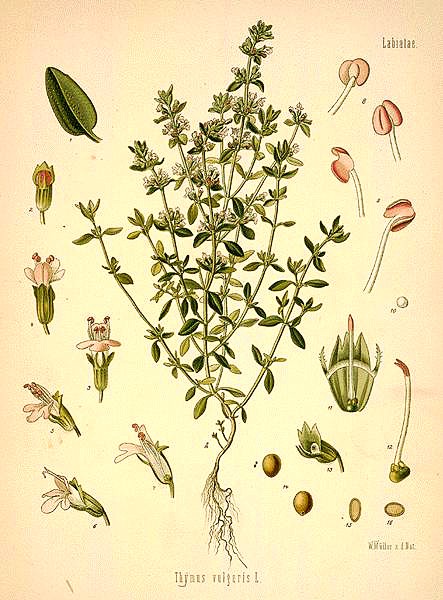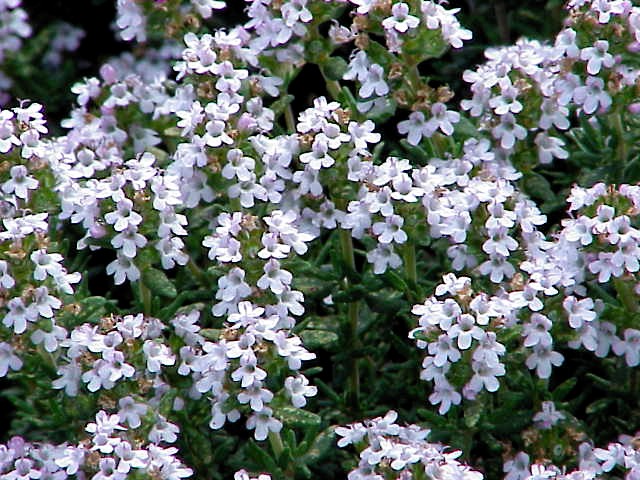Lessico
Timo
Thymum vulgare

Thymum deriva dal greco thımon che significa timo,
la pianta, a sua volta derivato dal verbo thıø = infuriare, agitarsi,
smaniare, forse per la decantata azione afrodisiaca e antimelanconica. Ambedue
i sostantivi sono neutri. Dioscoride![]() per indicare il timo usa thımos, maschile, ma per lo più questo
vocabolo significa escrescenza, oppure quell'organo linfatico situato alla
base del collo nel mediastino anteriore. Per Plinio
per indicare il timo usa thımos, maschile, ma per lo più questo
vocabolo significa escrescenza, oppure quell'organo linfatico situato alla
base del collo nel mediastino anteriore. Per Plinio![]() thymus, maschile, significa verruca, che è un'escrescenza. Giustamente
Pierandrea Mattioli
thymus, maschile, significa verruca, che è un'escrescenza. Giustamente
Pierandrea Mattioli![]() traduce thımos di Dioscoride con il neutro thymum. In base a ciò
si emenda Thymus vulgaris in Thymum vulgare, essendo vulgare
il neutro di vulgaris, ma si emenda solo nel nostro testo, lasciando
intatti i testi derivati da fonti del web.
traduce thımos di Dioscoride con il neutro thymum. In base a ciò
si emenda Thymus vulgaris in Thymum vulgare, essendo vulgare
il neutro di vulgaris, ma si emenda solo nel nostro testo, lasciando
intatti i testi derivati da fonti del web.
Pianta della famiglia Labiate propria dei luoghi aridi della zona mediterranea. Perenne, ha portamento cespuglioso con fusto legnoso, ramificato, alto 25-30 cm, e rami erbacei, sottili, pubescenti, portanti foglie opposte, lanceolate o lineari, di colore grigio e lanose nella pagina inferiore. I fiori sono piccoli, bianco-rosei, riuniti in brevi infiorescenze.
Tutta la pianta è fortemente aromatica e contiene un olio etereo costituito per il 20-40% da timolo e da quantità minori di carvacrolo, borneolo e tannini. È usato come aromatizzante in cucina e, sotto forma di essenza, in farmacia quale antisettico e balsamico.

Thyme is a well known herb; in common usage the name may refer to either the
- any or all members of the plant genus Thymus,
- common thyme, Thymus vulgaris, and a few other species that are used as culinary herbs, and for other medicinal uses.
Ancient Egyptians used thyme in embalming. The ancient Greeks used it in their baths and burnt it as incense in their temples, believing that thyme was a source of courage. It was thought that the spread of thyme throughout Europe was thanks to the Romans, as they used it to purify their rooms and to "give an aromatic flavour to cheese and liqueurs". In the European Middle Ages, the herb was placed beneath pillows to aid sleep and ward off nightmares. (Huxley 1992). In this period, women would also often give knights and warriors gifts that included thyme leaves as it was believed to bring courage to the bearer. Thyme was also used as incense and placed on coffins during funerals as it was supposed to assure passage into the next life.
Thyme is widely cultivated for its strong flavour, which is due to its content of thymol. Thyme likes a hot sunny location with well drained soil. It is generally planted in the spring and thereafter grows as a perennial. It can be propagated by seed, cuttings, or by dividing rooted sections of the plant. It tolerates drought well. Thyme retains its flavour on drying better than many other herbs.
Thyme is used most widely in cooking and provides lots of iron. Thyme is a basic ingredient in French, Greek, Italian, Lebanese, Spanish, Turkish and Persian cuisines, and in those derived from them. It is also widely used in Arab and Caribbean cuisines. Thyme is often used to flavour meats, soups and stews. It has a particular affinity to and is often used as a primary flavour with lamb, tomatoes and eggs.
Thyme, while flavourful, does not overpower and blends well with other herbs and spices. In French cuisine, along with bay and parsley it is a common component of the bouquet garni, and of herbes de Provence. In some Levantine countries, the condiment za'atar (Arabic for Thyme) contains thyme as a vital ingredient.
Thyme is sold both fresh and dried. The fresh form is more flavourful but also less convenient; storage life is rarely more than a week. While summer-seasonal, fresh thyme is often available year-round. Fresh thyme is commonly sold in bunches of sprigs. A sprig is a single stem snipped from the plant. It is composed of a woody stem with paired leaf or flower clusters ("leaves") spaced ½ to 1" apart. A recipe may measure thyme by the bunch (or fraction thereof), or by the sprig, or by the tablespoon or teaspoon. If the recipe does not specify fresh or dried, assume that it means fresh.
Depending on how it is used in a dish, the whole sprig may be used (e.g. in a bouquet garni), or the leaves removed and the stems discarded. Usually when a recipe specifies 'bunch' or 'sprig' it means the whole form; when it specifies spoons it means the leaves. It is perfectly acceptable to substitute dried for whole thyme. Leaves may be removed from stems either by scraping with the back of a knife, or by pulling through the fingers or tines of a fork. Leaves are often chopped.
Thyme retains its flavour on drying better than many other herbs. Dried, and especially powdered thyme occupies less space than fresh, so less of it is required when substituted in a recipe. As a rule of thumb, use one third as much dried as fresh thyme - a little less if it is ground. Substitution is often more complicated than that because recipes can specify sprigs and sprigs can vary in yield of leaves. Assuming a 4" sprig (they are often somewhat longer), estimate that 6 sprigs will yield one tablespoon of leaves. The dried equivalent is 1:3, so substitute 1 teaspoon of dried or ¾ tsp of ground thyme for 6 small sprigs. As with bay, thyme is slow to release its flavours so it is usually added early in the cooking process.
The essential oil of common thyme (Thymus vulgaris) is made up of 20-55% thymol. Thymol, an antiseptic, is the main active ingredient in Listerine mouthwash. Before the advent of modern antibiotics, it was used to medicate bandages. It has also been shown to be effective against the fungus that commonly infects toenails.
A tea made by infusing the herb in water can be used for cough and bronchitis. Medicinally thyme is used for respiratory infections in the form of a tincture, tisane, salve, syrup or by steam inhalation. Because it is antiseptic, thyme boiled in water and cooled is very effective against inflammation of the throat when gargled 3 times a day. The inflammation will normally disappear in 2-5 days. Other infections and wounds can be dripped with thyme that has been boiled in water and cooled.
In traditional Jamaican childbirth practice, thyme tea is given to the mother after delivery of the baby. Its oxytocin-like effect causes uterine contractions and more rapid delivery of the placenta but this was said by Sheila Kitzinger to cause an increased prevalence of retained placenta.
Thymus vulgaris (Common Thyme or Garden Thyme) is a commonly used culinary herb. It also has medicinal uses. Common thyme is a Mediterranean perennial which is best suited to well-drained soils and enjoys full sun.
Thymus herba-barona (Caraway Thyme) is used both as a culinary herb and a groundcover, and has a strong caraway scent due to the chemical carvone.
Thymus × citriodorus (Citrus Thyme; hybrid T. pulegioides × T. vulgaris) is also a popular culinary herb, with cultivars selected with aromas of various Citrus fruit (lemon thyme, etc.)
Thymus pseudolanuginosus (Woolly Thyme) is not a culinary herb, but is grown as a ground cover.
Thymus serpyllum (Wild Thyme) is an important nectar source plant for honeybees. All thyme species are nectar sources, but wild thyme covers large areas of droughty, rocky soils in southern Europe (Greece is especially famous for wild thyme honey) and North Africa, as well as in similar landscapes in the Berkshire Mountains and Catskill Mountains of the northeastern US.
Thyme names
Mexico:
Tomillo
Malta: Saghtar (pronounced 'saatar')
France: Thym. Provence thyme is also called farigoule.
Arabic speaking countries (Lebanon, Palestine, Jordan, Syria.. etc.): Za'atar
Poland: Tymianek
Turkey: Kekik
Sweden: Timjan
Israel: Timin
Romania: cimbru